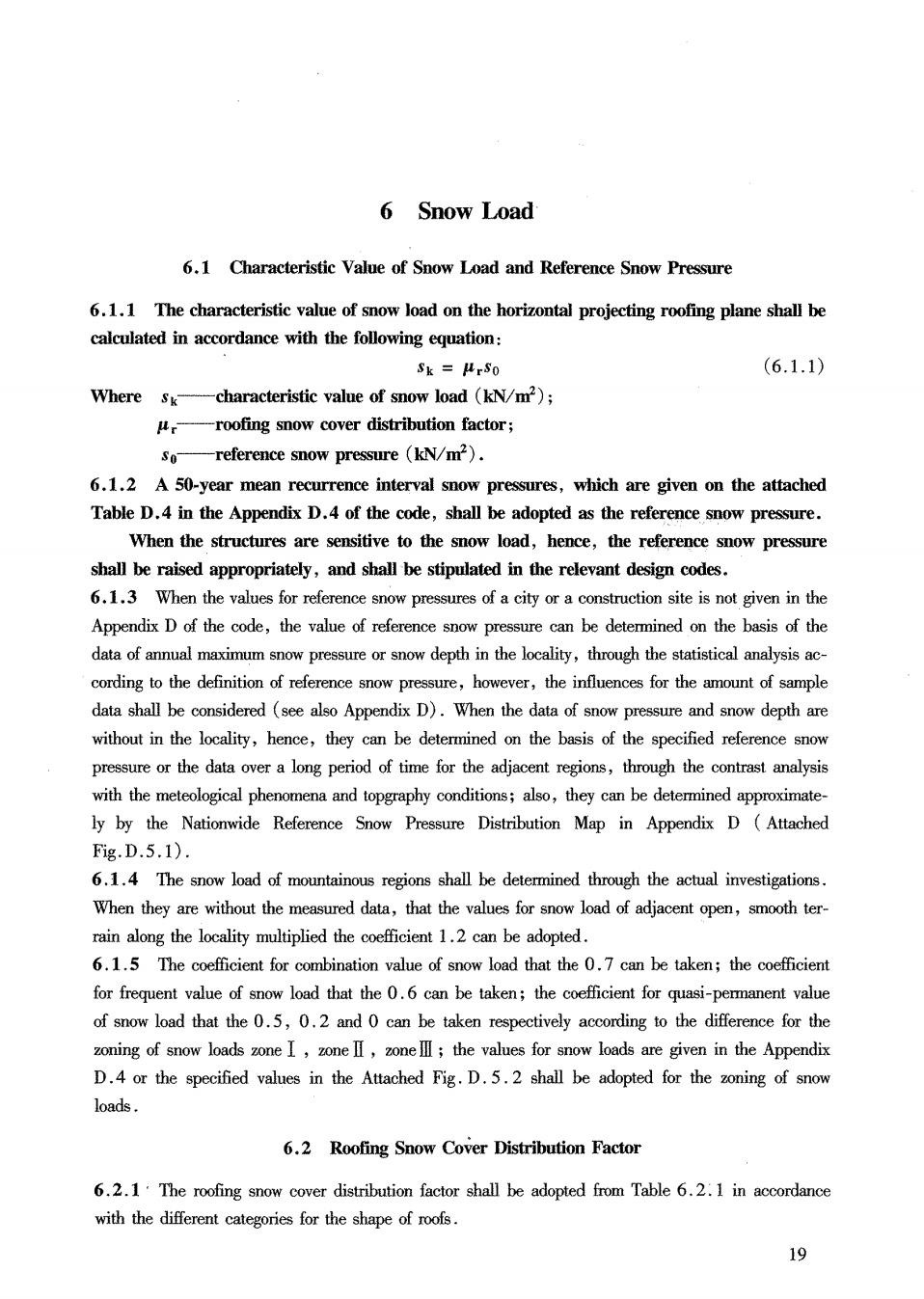
6 Snow Load 6.1 Characteristic Value of Snow Load and Reference Snow Pressure 6.1.1 The characteristie value of snow load on the horizontal projecting roofing plane shall be calculated in accordance with the following equation: (6.1.1) Wherecharacteristic value of snow load (kN/m); -roofing snow cover distribution factor; So -reference snow pressure (kN/m2). 6.1.2 A 50-year mean recurrence interval snow pressures,which are given on the attached Table D.4 in the Appendix D.4 of the code,shall be adopted as the reference snow pressure. When the structures are sensitive to the snow load,hence,the reference snow pressure shall be raised appropriately,and shall be stipulated in the relevant design codes 6.When the vles for referenceprre of cityorinsieiso gven in the Appendix D of the code,the value of reference snow pressure can be determined on the basis of the data of depth in the ocality,through the statistica analysisac cording to the definition of reference snow pressure,however,the influences for the amount of sample data shall be considered (D).When the data of snow pressure and snow depth are without in the locality,hence,they can be determined on the basis of the specified reference snow pressure or the data over a long period of time for the adjacent regions,through the contrast analysis with the meteological phenomena and topgraphy conditions;also,they can be determined approximate- ly by the Nationwide Reference Snow Pressure Distribution Map in Appendix D(Attached Fig.D.5.1). 6.1.4 The snow load of mountainous regions shall be determined through the actual investigations When they are without the measured data,that the values for snow load of adjacent open,smooth ter rain along the locality multiplied the coefficient 1.2 can be adopted. 6.1.5 The coefficient for combination value of snow load that the 0.7can be taken;the coefficient for frequent value of snow load that the 0.6 can be taken;the coefficient for quasi-permanent value of snow load that the 0.5,0.2 and 0 can be taken respectively according to the difference for the zoning of snow loads zone I,2oneⅡ,zoaeⅢ;the values for snow loads are given in the Appendix D.or the pcified values in the Attached FigD.5.shall be opted for of loads. 6.2 Roofing Snow Cover Distribution Factor 6.2.1 The roofing snow cover distribution factor shall be adopted from Table 6.2.1 in accordance with the different categories for the shape ofoof 19
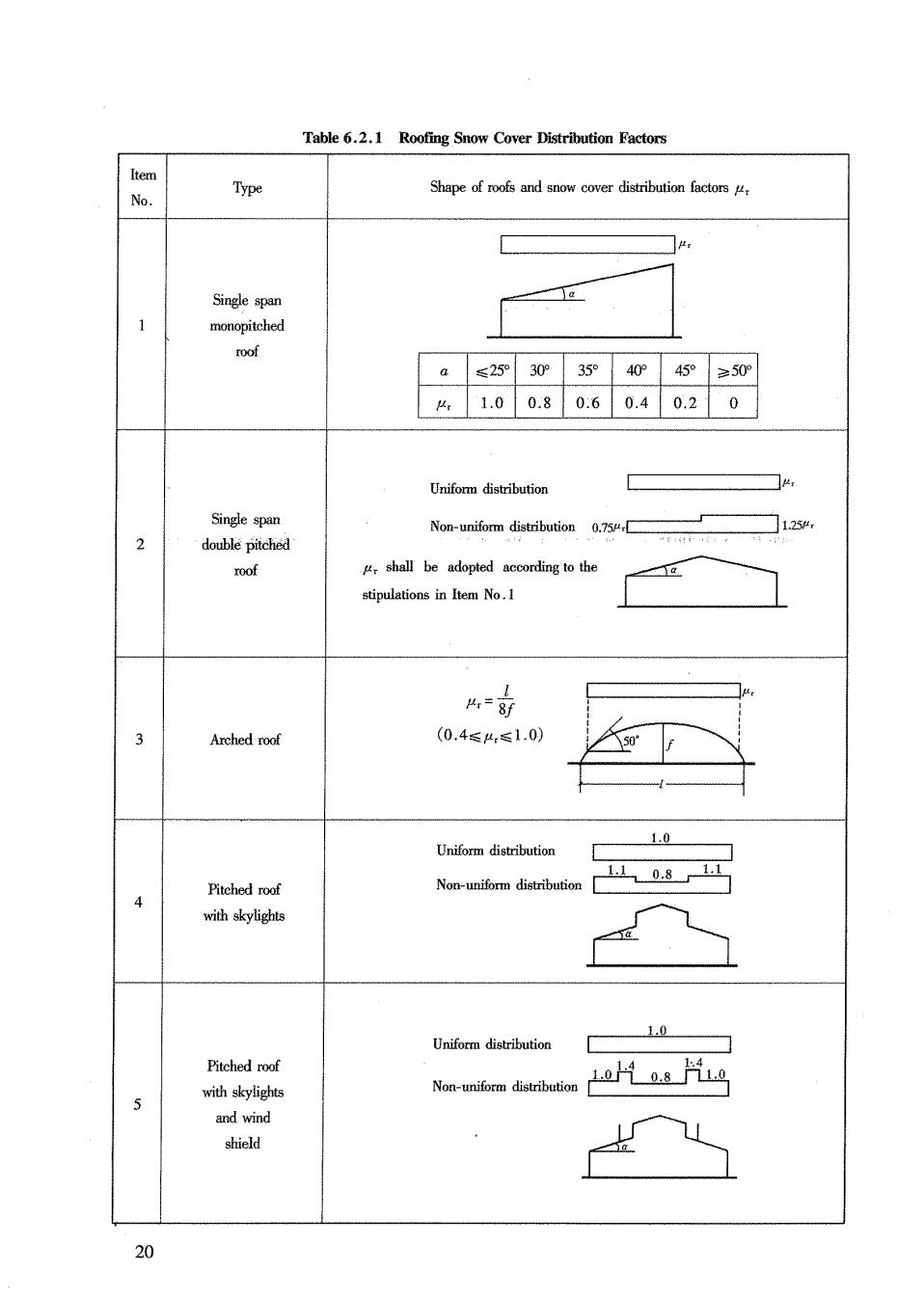
Table 6.2.1 Roofing Snow Cover Distribution Factors No. Shape ofoofandw cover distribution fctor roof a≤2530°35°4045°≥50 41.00.80.60.40.20 Single span Non-uniform distribution .5 2 stipulations in Item No.1 4,=8 Arched roof (0.4≤4,≤1.0) Uniform disributi 0 Pitched oof Non-uniform distribution wi油skylights 1.0 Pitched roof with skylights No-fomdistriio and wind 业u 20
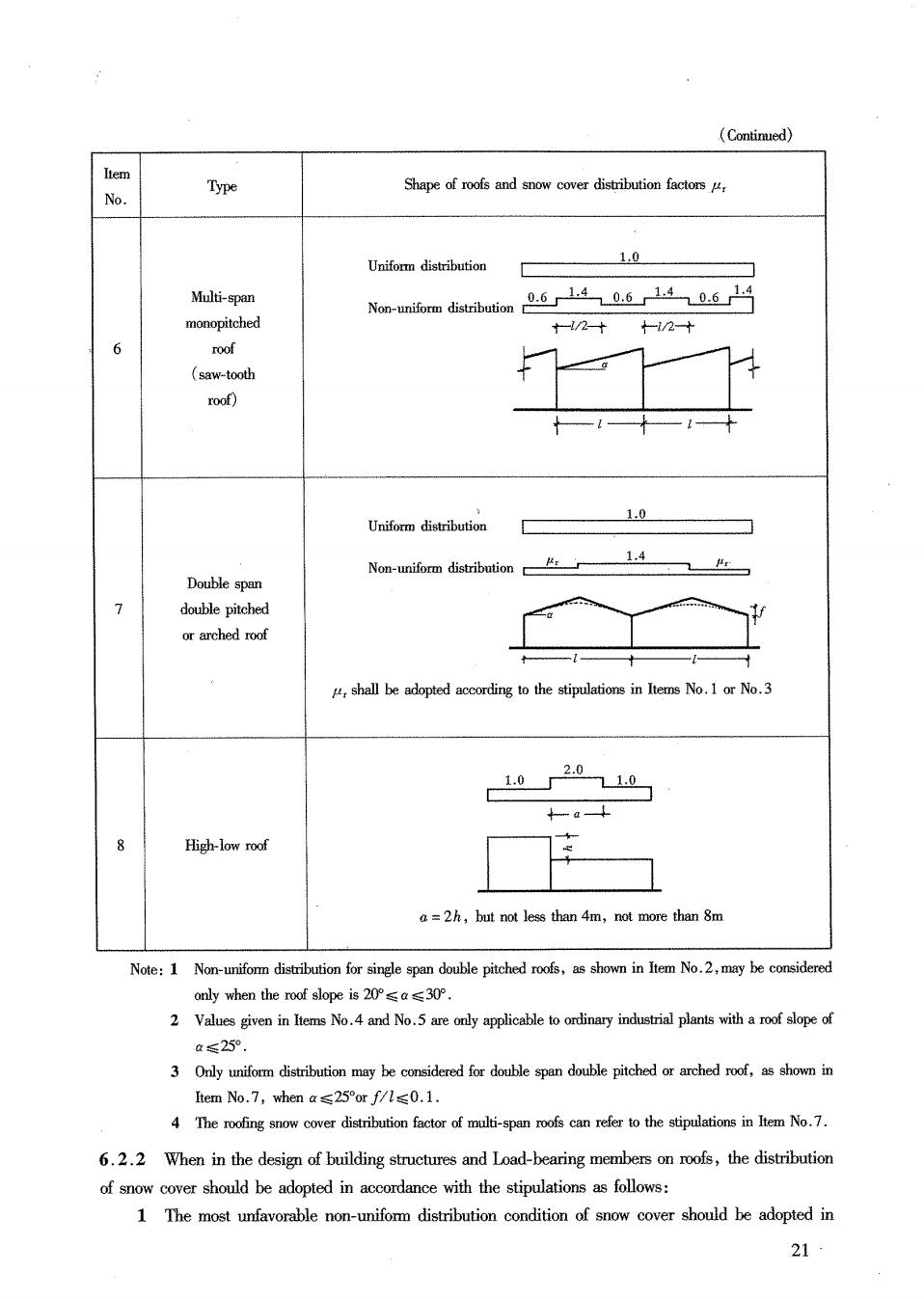
(Contined) No. Type Uniform distribution 1.0 Multi-span Non milom disrtiomn /2+-2+ (saw-tooth roof) 10 Non-uniform distribution 14 Double span 7 double pitched shall be the No.No.3 8 High-low roof 库 a=2h,but not less than 4m,not more than 8m Note:1 Non-ifom for double pitched in Item No.2,my be idere ony when the roof slope is20r≤a≤30e. a≤25°. 3 Only unifomm distribution may be considered for double spn double pitched or arched oofshown in Item No.7,whena25orf/l0.1. 4 factor of multi-spancan refer to the in tem No.7. 6.2.2 When in the design of building structures and Load-bearing members on roofs,the distribution of snow cover should be adopted in accordance with the stipulations as follows: 1 The most unfavorable non-uniform distribution condition of snow cover should be adopted in 21
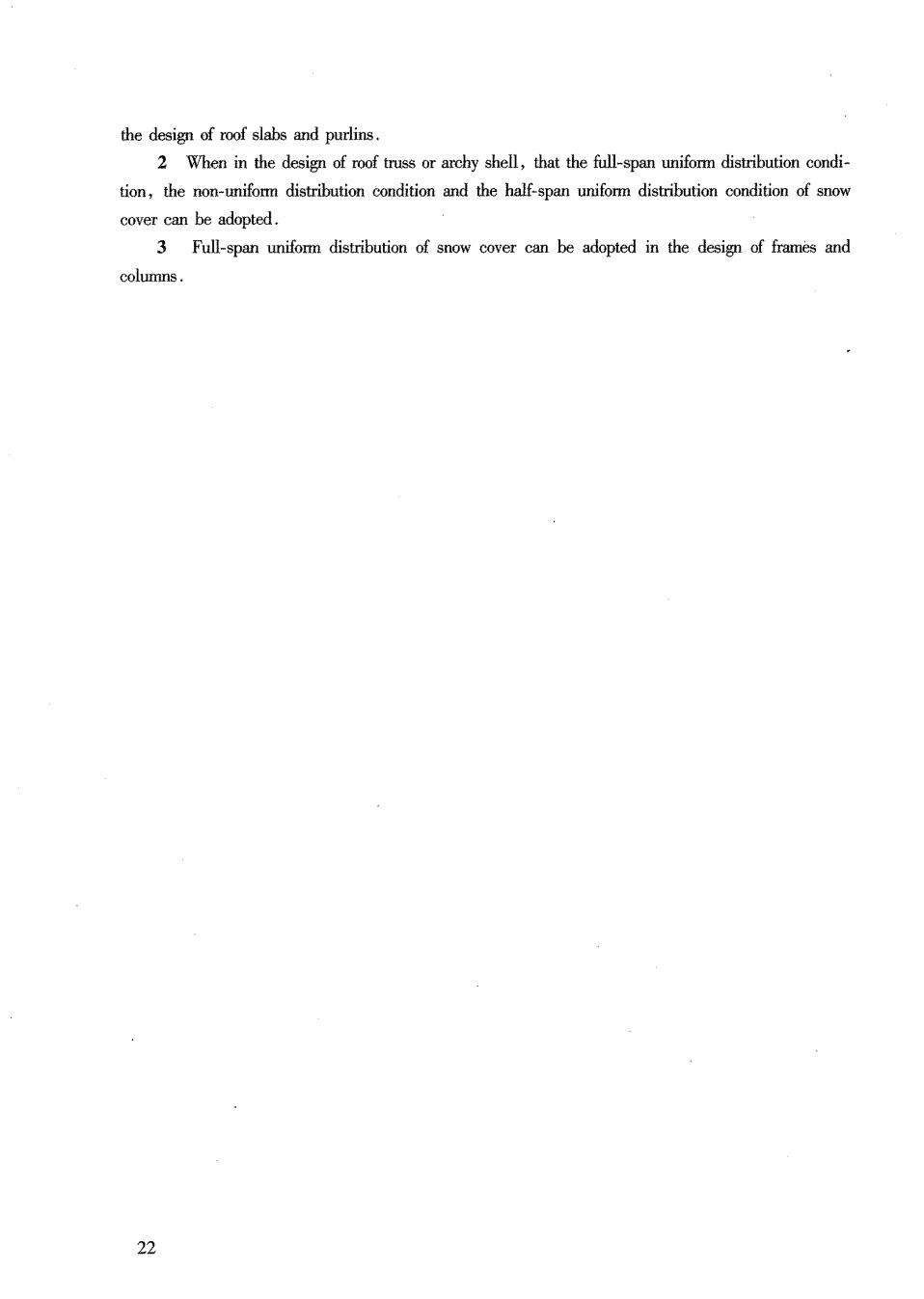
the design of roof slabs and purlins. 2 When in the design of roof truss or archy shell,that the full-span uniform distribution condi- tion,the non-uniform distribution condition and the half-span uniform distribution condition of snow cover can be adopted. 3 Full-span unifor distribution of snow cover can be adopted in the design of frames and columns
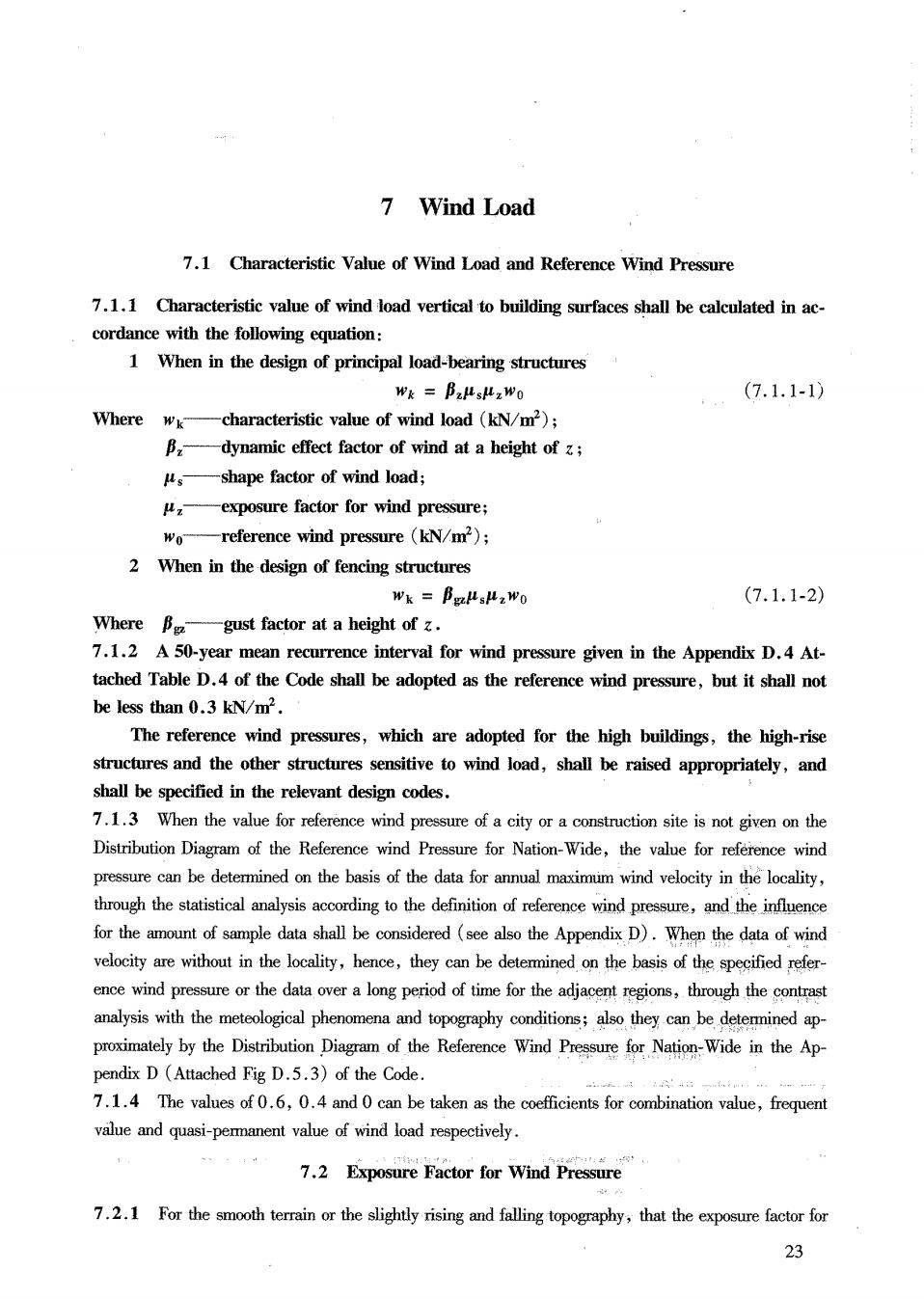
7 Wind Load 7.1 Characteristic Value of Wind Load and Reference Wind Pressure 7.1.1 Characteristic value of wind load vertical to building surfaces shall be calculated in ac- cordance with the following equation: 1 When in the design of principal load-bearing structures Wk B:HHwo (7.1.1-1) Where wx-characteristic value of wind load (kN/m2); B, dynamic effect factor of wind at a height of shape factor of wind load: 4z- -exposure factor for wind pressure; wo-reference wind pressure (kN/m2); 2 When in the design of fencing structures Wk BgusHzWo (7.1.1-2) Where B -gust factor at a height of z. 7.1.2 A 50-year mean recurrence interval for wind pressure given in the Appendix D.4 At- tached Table D.4 of the Code shall be adopted as the reference wind pressure,but it shall not be less than 0.3 kN/m2. The reference wind pressures,which are adopted for the high buildings,the high-rise structures and the other structures sensitive to wind load,shall be raised appropriately,and shall be specified in the relevant design codes. 7.1.3 When the value for reference wind pressure of a cityora construction site is not given on the Distribution Diagram of the Reference wind Pressure for Nation-Wide,the value for reference wind pressure an be determined on the basis of the datafor annual maxmm wind velocity in the locality through the statistical analysis according to the definition of reference wind pressure,and the influence for the amount of sample data shall be considered (se also the Appendix D).When the data of wind velocity are without in the locality,hence,they can be detemined on the basis of the specified refer- ence wind pressure or the data over a long period of time for the adjacent regions,through the const analysis with the meteologica phenomena and topography they can be deterined ap proximately by the Distribution Diagram of the Reference Wind Pressure for Nation-Wide in the Ap- endix D(Attached Fig D.5.3)of the Code. 7.1.4 The values of0.6,0.4 and 0 can be taken as the coefficients for combination value,frequent vale and quasi-peanent value of wind load respectively 7.2 Exposure Factor for Wind Pressure 7.2.1 For the smooth terrain or the slightly rising and falling topography,that the exposure factor for 23